NO MO’ NO MOW MAY(?)
What and Why?
The Month of May has ended, as has “No Mow May.” If you’ve never heard of “No Mow May,” it’s the rallying cry of a movement that began in the UK, suggesting that all of us who nurture greenswards abandon our efforts for the month of May. In so doing, habitat and food, in the form of early blooming wildflowers such as dandelions, clover, creeping Charlie, and violets, would become more available to early season pollinating insects.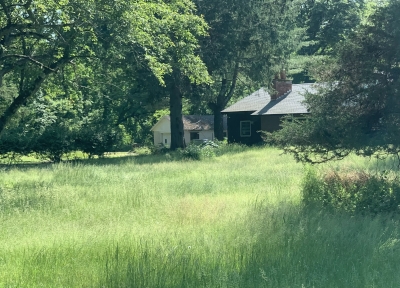
Let’s dive deeper into what “No Mow May” accomplishes, whether this movement has any drawbacks, and, finally, possible alternatives.
A lawn is typically a monoculture, or nearly so. Not mowing during this month when heat and rainfall spur rapid plant growth encourages more diversity, which makes environments more resilient.
Gasoline-powered mowers spew out great quantities of carbon dioxide and pollutants. Over the course of a year, one such machine pollutes the same amount as 43 new cars, each driven 12,000 miles! And all that noise. Not to also mention toxic pollutants entering the environment (13 billion pounds per year from lawns) and our collective lawns thirst for copious amount of water.
“No Mow May” puts a hold on all these environmental affronts, at least for the month.
Does It Fill The Bill?
Take a closer look at what this deliberate neglect has fostered. Peer at a no mow lawn, perhaps yours, and you’ll see some of the aforementioned wildflowers. Wait, though. Plants such as dandelion and creeping Charlie, are not native.  And dandelion, for one, can negatively impact animals and even other plants. Its pollen is nutritionally poor for bees, low in valine, isoleucine, leucine and arginine, all essential amino acids for honey bees. Problem is that bees can become faithful to one plant, so might fail to sufficiently pollinate other plants or ignore more nutritious pollen sources if they get started on dandelions. And dandelion’s allelopathic pollen inhibits seed development of some other plants.
And dandelion, for one, can negatively impact animals and even other plants. Its pollen is nutritionally poor for bees, low in valine, isoleucine, leucine and arginine, all essential amino acids for honey bees. Problem is that bees can become faithful to one plant, so might fail to sufficiently pollinate other plants or ignore more nutritious pollen sources if they get started on dandelions. And dandelion’s allelopathic pollen inhibits seed development of some other plants.
Leaving the mower parked in the garage or barn for May will, of course, change the appearance of your lawn, a look that has been part of our collective aesthetic from the past. Local ordinances might even prohibit “No Mow May.”
Despite certain drawbacks, mown lawn is functional, providing a soft, inviting surface for lounging, for playing, for picnicking, and other civilized activities.
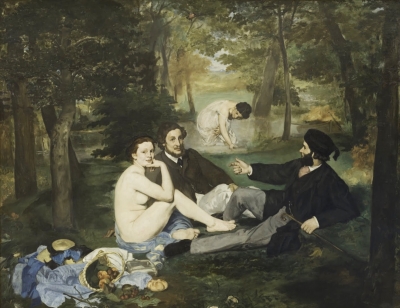
Manet’s “Luncheon on the Grass”
Tall grass is not nearly so inviting, especially as mice and other rodents feel more secure from predators scampering beneath the cover of long grass. Ticks enjoy such habitat, and are carried around by the mice, increasing threat of Lyme disease and other tick-borne illnesses.
Okay, so it’s the end of the month and you’re ready to mow. It’s not going to be easy to plow through all that vegetation. And all those clumps of grass clippings? You’ll probably have to rake them up so the lawn doesn’t get smothered.
The grass itself isn’t going to fair well with the drastic end-of-the-month pruning. Grasses are healthiest if blades are cut back by no more than one-third their length. So two mowings may be in order to bring grass down to mown height. If you wait a few days between mowings , then clippings from the first cut have time to dry out, so you may be able to forgo having to rake them up.
When all is said and done, does one month of not mowing an established lawn really encourage a burst of wildflowers or other biological changes? Probably not. The “No Mow May” lawns that I see look mostly just like unmown grass.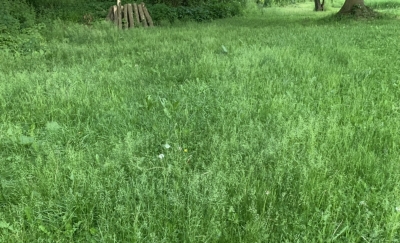
Alternatives
Probably the easiest way to get the best of both worlds, or at least some of both worlds, would be with “One Mow May” or “Less Mow May” rather than “No Mow May.”
Or, replace part of the lawn with a garden, perhaps a wildflower garden, or even just areas with groundcovers rather than lawn.
My top alternative to “No Mow May” is what I’ve called Lawn Nouveau, an idea I had years ago that reflected my lack of time and enthusiasm for mowing the lawn. Here’s an adaptation of Lawn Nouveau, as I described it in the mowing chapter — yes, mowing is a type of pruning — of my book The Pruning Book (available here, signed, or from the usual sources):
The low grass is just like any other lawn, and kept that way with a lawnmower. Other portions are allowed to grow, and are mowed infrequently –- one to three times a year, depending on the desired look. Mowings from the tall grass portions must be raked up after mowing or else they’d leave unsightly clumps and smother regrowth, but they are good material for mulch or compost.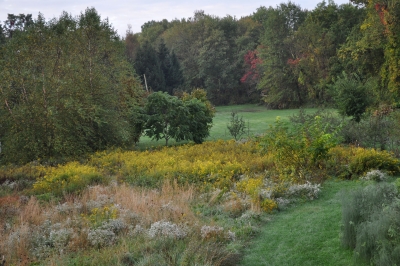
A crisp boundary between tall and low grass keeps everything neat and avoids the appearance of an unmown lawn. Tall and short grass can help define areas. Rather than straight edges and 90° corners, curves in bold sweeps can carry you along, then pull you forward and push you backward, as you look upon them. Avenues of low grass cut into the tall grass invite exploration, and, like the broad sweeps, can be altered throughout the season.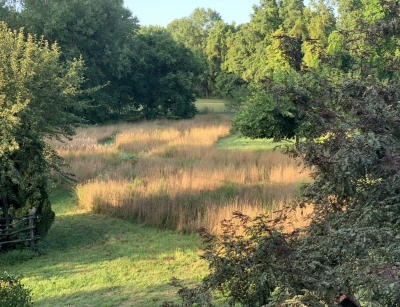
The “tall grass” becomes more than just grass as other plant species gradually elbow their way in. Which ones gain foothold depends on the weather and frequency of mowing. 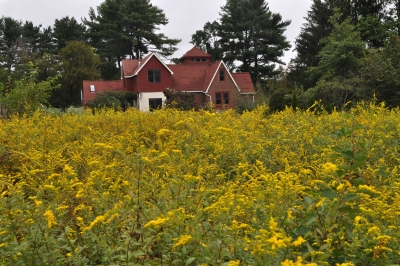 An attractive mix of Queen Anne’s lace, goldenrod, chicory, and red clover might mingle with the grasses in a dry, sunny area, with ferns, sedges, and buttercups mixing with the grasses in a wetter portion.
An attractive mix of Queen Anne’s lace, goldenrod, chicory, and red clover might mingle with the grasses in a dry, sunny area, with ferns, sedges, and buttercups mixing with the grasses in a wetter portion.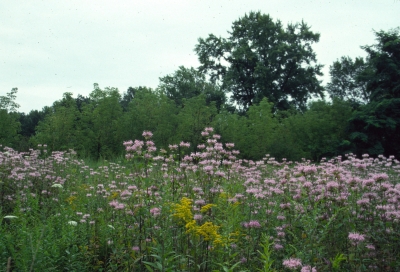
I now have a one-and-a half acre meadow which, along with some lawn around my home, constitutes Lawn Nouveau here. No need for large property, though; my original property was 3/4 acre, and that’s where Lawn Nouveau began way back when.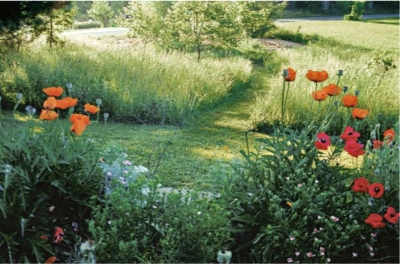
In Praise of the (Austrian) Scythe
My preferred implement for mowing the tall grass is a scythe. Not the so-called American type scythe, with a curved handle and stamped blade, which is put to best use decorating the wall of a barn. I use a so-called Austrian type scythe (purchased from www.scythesupply.com), which usually has a straight handle and is lightweight with a razor sharp, hammered-thin blade.
Much of my one acre meadow gets a once-a-year mowing with my tractor, but you’ll still find me out there early summer mornings with my scythe.  It’s a joy to step out in the dewy coolness and swing my scythe, the only sounds being that of birds singing and the scythe blade whooshing through the turgid, green stalks of meadow plants.
It’s a joy to step out in the dewy coolness and swing my scythe, the only sounds being that of birds singing and the scythe blade whooshing through the turgid, green stalks of meadow plants.
(For a short scything video, see https://leereich.com/video.)



Thanks as always for the interesting thoughts, Lee.
I’m grateful I don’t live in a situation where the neighbors notice my lawn, surrounded as we are by woods. i practice “Lawn Nouveau” partly by sloth and partly by design. I use my battery-powered lawnmower to keep the grass down in areas around the house, for comfort and for tick control, and mow the rest of it when I get to it, which winds up usually by section. Our lawn is a not hardly a monoculture and we do, in fact, have quite the interesting mix of flowers in the spring.
On that note –
https://www.bbc.com/news/uk-england-somerset-61583521
The link about the bluebells reminds me of a beautiful sight of a few weeks ago that a friend told me to check out. It was a lowlying section of woodland carpeted with forget-me-not to the extent that I thought it was water, at first, then a fog, before I realized it was forget-me-nots. I’m planting that in my mini-forest and hoping.
Forget me nots!!! I just pulled out about three wheelbarrow loads of tHem from various parts of the garden. They seed outrageously!! And then take over. I am moving them to sections of the property where they can just go wild. Beautiful, though..pink ones and blue ones and mixed up ones. Good luck!
I’ve had them here and there in the gardens for 20-30 years and keep moving them. Now they are going out of the gardens and into rough areas just outside of the woods. We live on a mountainside in Vermont.
I agree that they’re for the woods, not the garden.
Lee, thank you for all your valuable information in all your bulletins. My sons new neighbors recently moved into the house in April and have not mowed the lawn at all. I look forward to meeting them and introducing them to your newsletter posts specifically this one relative to no mo may.
You’re welcome. But mustn’t forget that a small patch of well-mown is very inviting for, as I wrote, “civilized activities.
So sorry for those who have HOAs…..although they can be helpful, I mostly find them too restricting and would not want to live in such a community. I have found that by leaving the lawn unmown for the month of May, my yard has slowly turned back to the way it should be…. more native wildflowers are showing up ….. and I have also thrown in a few extras like crimson clover to the mix! There are now lots of lovely early blooming plants such as buttercups, lyre leaf sage, vetch, deadnettle, white clover, thistle, other things I can’t remember the name of….and then dandelion of course! I truly believe it helps to let this grow for a bit….and the bees appreciate it! Thanks for the article.
I’ve been a bit dubious of No Mow May, but it could be a good gateway for some to start doing better by bees of they’re given other, more valuable, things to do.
In the northern US, May is critical to a healthy lawn, so I think anyone who wants or needs a quality lawn could do more damage trying to get it back in shape.
Shrinking a lawn to what is actually needed is far better, in my opinion. I shrunk our lawn years ago and the woody and herbaceous perennials and leaf and wood litter are doing more 24/7 than an unmowed lawn for 31 days.
Also, spring offers an abundance of native pollen sources in the form of flowering shade trees.
I think we need a rake-free spring and fall more than a no mow May
The painting “Dejeuner sur l’Herbe” is by MANET, not Monet. Probably an autocorrect error, but accuracy is deserved, wouldn’t you agree? Love your Nouveau Lawn concept. My guy is currently re-wilding much of our property with native species, already in tandem with many of your suggestions. Varigating the mown areas with grown areas really does make the design look purposeful and not a willful violation of my city’s mowing code. Can’t wait to check out a scythe.
Thanks for the correction; yes, it is important.
You’ll find that, with some good instruction and practice, that kind of scythe is a joy to use, and very practical. Perhaps sometime I’ll write something about using a scythe.
Where did that gas mower statistic come from? That’s astounding.
I can’t remember for sure but I think it may have been the EPA. Do a web search and you’ll find it also.
I have been wondering about the effectiveness of No Mow May for some of the reasons you mention, so this is very helpful information.
I also have wondered if not mowing allows invasive weeds to flourish in some cases. There is an empty plot next to mine that is usually kept relatively well mown. This year, the owner did not mow until June, and it became covered in thick stands of garlic mustard and other nasties. Perhaps they were there before, but I just didn’t notice? I’d love to know if there’s been any research on this.
I don’t know if there’s any research on what you posit. But I would say it’s a definite possibility, depending on the site’s history, location, etc.